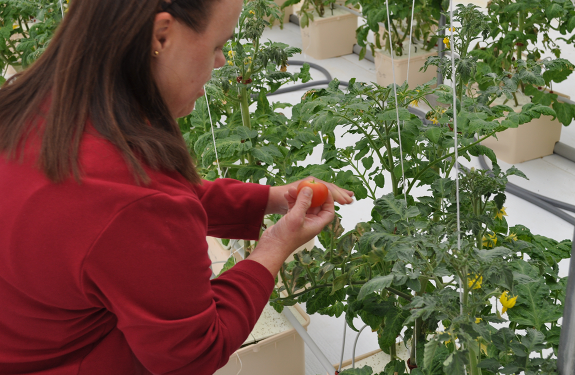Jerry and I, plus several staff members and 16 Ranchers with Down syndrome just returned from Indianapolis where we attended the annual convention of the National Down Syndrome Congress.
Jerry and I went in a few days early in order to visit a sister village community in Ohio, about an hour away. It's called Safe Haven Farms, and is the brainchild of Dennis and Ann Rogers, who have a 34-year-old daughter with severe autism.
Safe Haven Farms could easily double as a movie set, with its beautiful buildings nestled in the gentle green hills, gardens, ponds with ducks on parade, grazing llamas and miniature horses.
As we drove in the front gate, a tall, very thin young man planted himself right in the middle of the narrow lane. He was accompanied by a staff member, who attempted in vain to convince him to move out of our way so we could drive in. We waved at her to indicate she shouldn't stress about the situation; we were in no big hurry.
Several minutes later the young man moved of his own accord and the pair continued their journey to wherever they were going. All he needed was time to make up his own mind about the situation.
Dennis and Ann met us and gave us the royal tour. We swapped stories as we went along and at one point, as we were headed to the residence cottages Ann said, “I'll just stop in and see how our girl is doing today. She's been having a hard time of it the last few days.” I offered to accompany her and received an instantaneous and emphatic “No!” I got the message and continued on with Dennis and Jerry.
Dennis showed us homes customized for adults on the severe arc of the autism spectrum–painted flowers and murals on the walls instead of mirrors or pictures, TVs completely encased in wooden cabinets that prevented their being picked up and thrown. No glass. Shades encased within double paned safety-glass windows and operated by a lever to adjust the amount of light coming in. Plus many similar accommodations. It sounds stark, but the homes look like what they are–homes.
Needless to say, Safe Haven's staffing ration is quite a bit higher than ours, one-on-one to two and sometimes three-on-one. Ohio has a regulation that does not permit the landlord–individual or corporate–to provide the programming for people with intellectual disabilities, so all program and staffing is handled by Bittersweet Farms, another provider.
When Ann and Dennis despaired over ever finding a living situation suitable for their daughter after she left high school, after several spectacular failures, they decided in the mid 2010's to take on the task themselves. They understood as few others the challenges involved in caring for a son or daughter on the severely-affected end of the spectrum.
They were encouraged by government agencies, and why wouldn't they be? Here were two incredibly energetic, experienced people ready to devote their lives and their fortune marshalling resources to create a place where the most difficult to serve men and women, like their daughter, could live and grow. (And incidentally, in doing so, they would save the taxpayers of the US and of Ohio millions of dollars and provide the best care possible. two eminently worthy goals!)
Well, that was then. The day before our visit the state head of the Department of Disabilities visited to gather information and provide feedback concerning the rules promulgated by the Centers for Medicaid and Medicare Services of the federal government.
These are the rules that say: No segregated environment. No one-disability communities. No rural villages. No names like “Safe Haven.” (Heaven forfend! Do they prefer “Hell's Kitchen?”)
And for that matter, no in-ground swimming pool, a much-desired item for the Farm.
Why not? The Farmers love to be in the water. Several are good swimmers, but even those that don't swim love the feel of the water on their skin. (My theory is that it's because the water helps them know where they leave off and the rest of the world begins.)
But…having your own swimming pool is “institutional,” and you should really be taking the Farmers to the nearest community pool to swim.
Now the following are purely my own observations, and I ask, in what universe are these people living? Do they have any understanding at all of the challenges involved in providing optimal care for adults on this part of the spectrum? I cannot believe that they do.
I met a very well known advocate for people on the spectrum, who is herself on the spectrum. She is rightly famous, and lauded for her many accomplishments. At the time I was accompanied by one of our Ranchers, a man on the spectrum who struggles tremendously with anxiety, Tourette's, and OCD. He knew of her work and wanted to meet her.
This man picked out Down Home Ranch as his home many years ago, long before we had an opening for him. (In fact, when he learned he could not come right away after doing his residency trial, he filled a jug with water and ran away, determined to live here at the Ranch even if he had to do it in the woods!).
This women dressed me down then and there, saying that he should be living on his own, he was obviously smart and capable, and he had no reason to be living sequestered out in the country somewhere on a “segregated” ranch.
But what about the fact that he loves the Ranch? He can go fishing whenever he wants. He grows his own garden and takes care of it by himself. He loves nature and feels comforted being in the outdoors. Does he get a choice in this matter?
Village communities all over the country are organizing to address this rule. We are not saying everyone should live in a village community.
But why are the advocates so determined that nobody should?
